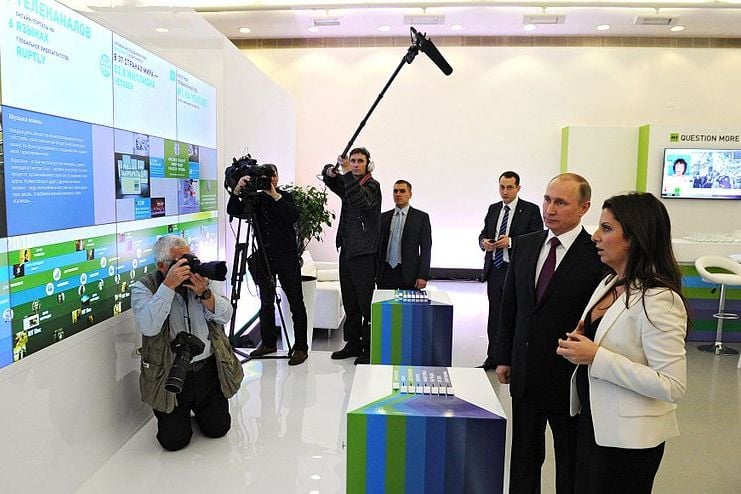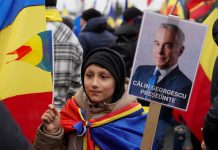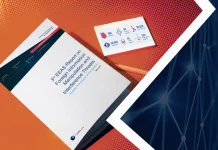
Today, the perception of Vladimir Putin in Europe is both overblown and distorted, writes Olga Irisova for New Eastern Europe. His most zealous opponents and sympathisers across the various ideological planes perceive him not according to his actual character, but rather through the myth of him as a strong leader who fights terrorism and has brought economic success to Russia, especially during his first two terms in office (although from 1998 to 2010 the real income of the population increased only twofold, when oil price grew almost 10 fold). To many in Europe, Putin is perceived as a leader with unconditional support from his population, who defeated injustice through his victory over the oligarchs.
This image of “Putin the hero” in Europe is promoted not just by Russian media outlets with a focus on foreign audiences, but also with the help of local media that is either “bewitched by him” or sponsored directly by the Kremlin. According to civic activist Juraj Smatana, there are more than 40 websites that propagate pro-Russian sentiments in Slovakia. Such a large number may suggest that they are being funded from outside the country. The scale of the Kremlin’s campaign to promote its vision of the world is reflected in the list of participants in the so-called “World Congress of Russian Press”, most recently held in Moscow in June 2015. More than 500 Russian-language media outlets from 63 countries attended this event, making it nearly impossible to grasp the scale of penetration of Kremlin propaganda.
Media as a threat
The main “consumers” and victims of Russian propaganda are Russian citizens themselves, forced to live in a distorted and hostile reality. It is important to be aware that in the future, Putin will leave office, but the environment he has created will remain and the quality of Russian relations with the rest of the world will be defined by the state of the society he has left behind. This is why it is important to not only fight Kremlin propaganda in Europe, but also attempt to start examining and healing Russian society to ensure peaceful co-existence in the future.
This essay is from the previous issue of New Eastern Europe – A Sea of Change.
In order to understand the devastating nature of Kremlin propaganda, we need to go to its source and look at the visible effects it has already had on Russian society. The process of tightening the screws in Russia is connected to the creation and development of all the preconditions needed to legitimise and institutionalise propaganda. Although censorship in the mass media is prohibited under Article 3 of the Russian Federation’s Law on Mass Media, asserting that it does not exist today is pointless. The conversion of Russian media into the Kremlin’s mouthpiece is reflected in the restrictions on press freedom and the country’s poor international rankings in this regard. Reporters Without Borders ranked Russia 152 out of 180 countries in its 2015 World Press Freedom Index, dropping four places in just one year. Even Turkish and Venezuelan media outlets fare better.
The authors of the report note that the current restrictive climate in Russia can be directly attributed to Putin’s presidential return in May 2012. As a direct response to civil society activity in Russia, the government introduced a number of harsh measures, including the adoption of a series of draconian laws that significantly restrict freedom of information. Right at the beginning of his first term, Putin issued a decree on the “Concept of Information Security”, which divided the media into “good” and “bad”. Even then, it was already understood that any criticism of the authorities in the media would fall under the “bad” category. Within this decree, a separate clause was dedicated to what the Kremlin deems to be one of the most dangerous internal threats to Russia’s information security in relation to its foreign policy – the “information propaganda activity of political forces, NGOs, the media and individuals who misrepresent the country’s foreign policy strategy and tactics”. If the media or public figures interpret the Kremlin’s foreign policy differently to Moscow, they are considered a threat to Russia’s national interests.
The process of stifling independent television journalism in Russia began on the night of April 13th 2001, when the state took over and nationalised the previously-independent NTV. Putin clearly understood the power of television in Russia. Nearly 90 per cent of Russians form their opinion of the world solely based on what they see on TV and by removing “unnecessary” facts from television programmes, the Kremlin has also distorted reality for millions of TV viewers. Large TV networks have been subject to the dictates of the Kremlin for years, whereas print and internet media enjoyed a longer period of relative freedom, having posed far less of a danger to the “Lord of the Kremlin”.
Red line
In Russia there is one available alternative to Kremlin-controlled television – the independently-owned Dozhd, or TV Rain. However, this channel, which is not widely available, targets a very narrow audience – primarily those who already share a certain point of view and are willing to pay for content. Most Russians would never consider purchasing a subscription and paying to watch alternative channels when they can watch state-run ones for free.
With their ability to capture the attention of the wider public, regional television stations, unaffiliated with the government, have greater potential to challenge the existing status quo. In contrast to Dozhd’s narrow audience base, a quality regional channel is able to attract people of completely different political orientations and until recently, focus on coverage of local events and criticise local authorities and companies, as well as corrupt officials. However, the existence of such bastions of free regional TV journalism is tolerated by the Kremlin as long as their work does not directly contradict the key tenets of state policy.
A “demonstrative flogging” was recently held to show that there is a red line which, if crossed, can lead to serious consequences. The victim in this case was the local channel Tomsk TV-2, which aired a story about Russia sending (volunteer) fighters to Ukraine’s Donbas region. Without adequate explanation, the Federal Service for Supervision in the Sphere of Telecom, Information Technologies and Mass Communications (Roskomnadzor) withdrew the channel’s license, which had originally been issued until 2025. The Russian Television and Radio Broadcasting Network (RTRS) later refused to renew the channel’s broadcasting contract. With the same bureaucratic red tape used by Roskomnadzor, the Kremlin then closed down the Crimean Tatar channel ATR. Knowing that Roskomnadzor has already established a system to disable disobedient media outlets, many outlets practice the art of self-censorship. Though no formal regulation or law exists, the set of ideas developed by the Kremlin’s gang of political technologists is well known and extremely dangerous to challenge.
The turning point in the state’s control over the media came in November 2012, when amendments to the Law on the Protection of Children were adopted. This amendment prohibited information deemed “harmful to the health and development” of children and resulted in the creation of a single registry of websites blocked for containing “prohibited information”, which became known as the “blacklist of sites”. Roskomnadzor was behind the creation of this registry. Furthermore, on February 1st 2014, the Lugovoi Law, named after the Duma member who sponsored it, entered into force and authorised the prosecutor general’s office to block online sources within 24 hours without any court approval.
According to official data, Roskomnadzor has blocked 52,000 websites since 2012 at the request of the prosecutor’s office, but data from an independent organization called Roskomsvoboda estimates that over 260,000 domains have been unjustly blocked.
Shrinking space
In the last 15 years Putin and his team have succeeded in creating a well-oiled control mechanism over the media that specifically targets those identified as having “anti-Putin” views and sympathy towards the West. This is set to continue. The Russian censors of the 21st century shelter themselves behind lofty slogans, while obediently carrying out orders from the Kremlin. The shrinking space for freedom of expression on the internet was set to be constricted even further on August 1st 2014, when the “blogger law”, which imposes restrictions on users of social media, came into effect. This set of regulations requires any person whose online presence draws more than 3,000 daily readers to register, disclose personal information and comply with the same regulations as mass media.
In the spring of 2015 hackers posted a mobile text conversation allegedly belonging to Timur Prokopenko, deputy head of domestic policy within the presidential administration, which provides an excellent insight into Roskomnadzor’s true role. In the message, Prokopenko states that Roskomnadzor has repeatedly “provoked” the liberal, independent media, while ignoring illegal nationalist attacks made by media loyal to the Kremlin.
Moreover NGOs monitoring the status of media in the country have been placed on a list of “foreign agents” and a new law restricting the shares of foreign ownership in Russian media companies by 20 per cent will come into effect in 2016.
Though the current information blockade does not yet have a single legislative authority, this will soon change. It is no coincidence that during Russia’s invasion of Ukraine, a new information security approach was developed. This policy, which will address such dangers as other countries using information technology “in order to gain intelligence and achieve political and military objectives”, influencing the development of the Russian Internet and addressing the lack of co-ordination regarding authorities’ activities on security issues at different levels. Once again, the focus is on identifying external threats, not on protecting freedom of expression and the media. The oppressive climate for those who question the Kremlin narrative continues to grow, with dissent either brought under control or erased from existence.
The negative rhetoric of the Kremlin’s mouthpieces does not go by without having an effect on the public’s mental health. Phobias such as homophobia, liberalophobia and Americanophobia, which are supported and stimulated by the media, lead to an increase of intolerance and aggression in society. Back in 2013, experts from the Institute of Psychology of the Russian Academy of Sciences published the results of their study on the changes in the typical psychological profile of a Russian citizen from 1981 to 2011. It turned out that Russians became three times more aggressive and rude over the course of 20 years and it was also noted that the influence of media was one of the key factors behind this.
However, a lot has changed since 2011, including the manner in which information is presented. During the era of the Soviet Union, trained presenters read the news in orator-style voices, using official and sometimes stilted language. Today’s style, forged by the aggressive pro-Putin TV personality Dmitry Kiselyov, is at the peak of its popularity and features typical jibes, threats and over-the-top theatricality. Even though Kiselyov himself was once seen as an exceptional phenomenon, the majority of TV personalities and journalists have now copied his aggressive trademark style. The media (especially since the days of the EuroMaidan in Ukraine and the annexation of Crimea) have greatly accelerated their fermenting of the aggressive mood in Russia at present.
Traitors everywhere
An increase in aggressiveness inevitably leads to an increase in the crime rate, which is confirmed by official statistics from the Russian Ministry of the Interior. In the period between January and September 2015, more than 1.5 million crimes were recorded in Russia, almost a seven per cent increase from the year before. Since the active development and promotion of “the fifth Jewish column” myth in Russian media, there has been an upsurge in anti-Semitism, whilst citizens dissenting against the Putin regime are quickly labelled as “agents of the US Department of State”. On the one hand, this leads to the perpetuation of the myth of sponsored oppositionists hiding in society and the need to fight them. On the other hand, Russians who are critical of the authorities but do not engage in political or media activity, refrain from voicing their views for fear of stigma or being labelled a “traitor of the motherland”.
Another novelty introduced by the masterminds of Russian propaganda are the trolls flooding both Russian and foreign websites. One of their headquarters is located in the St. Petersburg district of Olgino. Their activities aim to misinform and more generally negatively impact the psyche of those who are used to getting their information from the internet. Firstly, the vocabulary and tone adopted by paid-for commentators is far more aggressive, often making direct calls for extremism. Secondly, swarm attacks by trolls result in the majority of liberal, or simply moderate, web editions opting to disable their comments sections altogether, thus depriving the online community of the opportunity to exchange genuine unfiltered views. On websites where comments remain open, one anti-Putin statement is counteracted by a flurry of offerings in the spirit of Kiselyov’s “militant pseudo-patriotism”, leading to a feeling of isolation for those who fully or partially disagree with policies pursued by Putin. It is obvious that the trolls have not been created to prove something, but to create the illusion of the existence of an active majority which supports the regime. When a Russian is critical of the Kremlin or a particular policy, he or she is practically told: either you grin and bear and tacitly support it, or leave the country and take your views with you. A different message is sent to those who passively support the authorities. It is not enough to be pro – one should also be openly and aggressively against those who are not supportive of the Kremlin.
It is important to emphasise that the current situation is not static and with time, the atmosphere of intolerance created by propaganda will continue to grow. The economic crisis and its consequences are only now beginning to be felt, which will inevitably result in an increased level of dissatisfaction and depression amongst society. These moods, mixed with aggressive attitudes towards the West and the opposition, while stoked by the media, have the potential to turn into a wave of violence and social unrest. Ironically, it is the regime itself which may in the end become a victim of its own aggressive social meddling.
By Olga Irisova, New Eastern Europe
Olga Irisova is an analyst at the Center for Polish-Russian Dialogue and Understanding and a senior editor and member of the editorial board of the “Intersection Project”.
The author was a speaker at the session of the Warsaw Security Forum 2015 – http://warsawsecurityforum.org/. This article is based on previous publications within the Intersection Project, an online analytical platform on Russia, established by the the Centre for Polish-Russian Dialogue and Understanding, which is a partner of the Warsaw Security Forum 2015.





